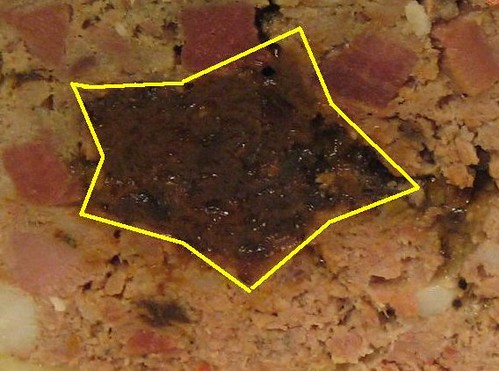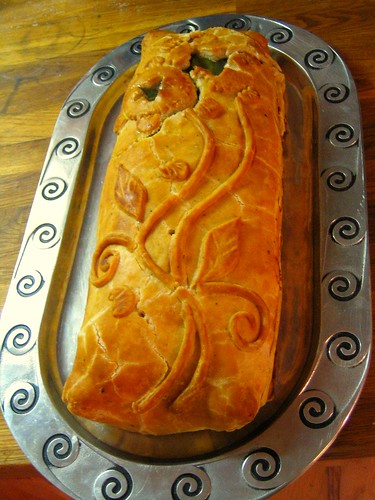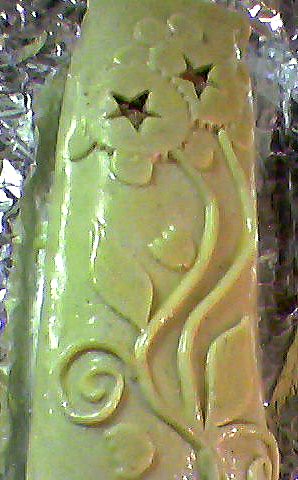Pâté Pantin Richelieu,
édition speciale prunes et pistaches.
édition speciale prunes et pistaches.
Made for the celebration of a good friend’s enthusiastic restaurant review, his first in the capacity of Chef. In keeping with the star flavored theme and obsession with restaurant reviews*, the chimneys are star shaped and the prune and pistachio inlay was star shaped, though the shape compressed during cooking.
Recipe technique and theory (albeit not up to snuff but acceptable for an inaugural attempt) inspired by Larousse Gastronomique and Escoffier formulations for forcemeats and farce à gratin. Forcemeat was comprised of 20% farce à gratin, 60% ground meat and 20% cooked garnish (diced ham, beef tongue and fatback).
The prune and pistachio inlay (generally cooked chicken or duck liver -the Richelieu characteristic) was made by filling a star shaped tube with ground prunes and pistachios, freezing it, unmolding it and placing it in the middle of the forcemeat. The star shaped tube was fabricated by scoring an 11cm long piece of flexible plastic alternatively on the other side every 1 cm and then bending the plastic so t hat it folds like an accordion. The ends are brought together and overlapped producing a tube and when compressed a bit it makes a star.
hat it folds like an accordion. The ends are brought together and overlapped producing a tube and when compressed a bit it makes a star.
Overall the pâté was a marginal success and failures are a vital bittersweet step in understanding what went right, what went wrong and why. A culinary mentor reminded me that anything worth fucking up is worth fucking up twice and urged me to consider how many things he had fucked up in a 35 year career. Successfully following a recipe does little more than prove solid reading skills and attention whereas understanding the theory comes from the practice and experience in experimenting the limits of fat, water, salt, temperature and time.
Initial, humble shortcomings:
1. Forcemeat: The meat was marinated in plum wine with olive oil, rosemary, carrot, onion, bay leaf, rosemary and a splash of cider vinegar. The vinegar should have been omitted as its purpose it better suited for marinated large joints or meats to be roasted and it may have cooked some of the meat and lead to oxidation. The cooked texture had a dry and crumbly appearance. It was not as tight and smooth as it should have been and had a brown-to-pink color gradient rather than pink throughout.
This may have been a result of the farce à gratin which was made by sautéing pork belly, the liver, red onion, deglazing and puréeing with 40% of the ground meat. If anything, the liver should have been cured with #1 to maintain a pleasant pink color, but ideally the farce à gratin should have been omitted or kept raw. When cooking, the forcemeat released a frightening amount of “juice”. The forcemeat may have been to fatty.
On the plus side, the flavor of the forcemeat was decent and the tongue garnish & ham was properly cooked (each inject with and cured in brine with curing salt for 4 days and simmer until tender in plainly salted water with a few vegetable aromatics until tender)
2. Pastry:
The short-crust pâte à foncer was 60% fat (½ butter, ½ lard) and after making the dough a few times the water amount should have been increased, though initially the dough looked too wet and I was hesitant to add the entire amount of water. The flavor was good and seasoned with salt (just a bit too much) and ground black pepper. The pastry was wrapped around the forcemeat and overlapped under the entirely. The overlap should have extended up the sides or the pasty should have been thicker. As the pâté cooked it compressed and its weight caused the pastry to tear and lose all the juices. The pastry should have held all the meat in place. Furthermore, a disastrous crack formed between the chimneys, ruining the visual aesthetics and handywork.
3. Aspic:
The aspic was far to thin (too little gelatin) and began to melt at room temperature. It was properly seasoned but could have used some Madeira or Port wine.
Conclusion:
The forcemeat should have contained all raw proteins outside of the garnish and been leaner. Vinegar should have been omitted from the marinade as it was likely to cause unsavory color change. The pâté itself should have been smaller and less forcemeat would have caused less structural issues. The pastry should have been thicker, especially in areas where liquid was likely to collect. The star should have been made from a cooked protein that wouldn’t have compressed. Apologies to Logan for using him, his celebration and guests as guinea pigs, though I ambitiously hadn’t anticipated a less than perfect specimen.
*The 0-4 star rating scale is stupid. If wines and school children are graded on a scale of 1-100, so should restaurants since the ½ star gradient does little to differentiate one restaurant from another or merit from more merit.
Recipe technique and theory (albeit not up to snuff but acceptable for an inaugural attempt) inspired by Larousse Gastronomique and Escoffier formulations for forcemeats and farce à gratin. Forcemeat was comprised of 20% farce à gratin, 60% ground meat and 20% cooked garnish (diced ham, beef tongue and fatback).
The prune and pistachio inlay (generally cooked chicken or duck liver -the Richelieu characteristic) was made by filling a star shaped tube with ground prunes and pistachios, freezing it, unmolding it and placing it in the middle of the forcemeat. The star shaped tube was fabricated by scoring an 11cm long piece of flexible plastic alternatively on the other side every 1 cm and then bending the plastic so t
 hat it folds like an accordion. The ends are brought together and overlapped producing a tube and when compressed a bit it makes a star.
hat it folds like an accordion. The ends are brought together and overlapped producing a tube and when compressed a bit it makes a star.Overall the pâté was a marginal success and failures are a vital bittersweet step in understanding what went right, what went wrong and why. A culinary mentor reminded me that anything worth fucking up is worth fucking up twice and urged me to consider how many things he had fucked up in a 35 year career. Successfully following a recipe does little more than prove solid reading skills and attention whereas understanding the theory comes from the practice and experience in experimenting the limits of fat, water, salt, temperature and time.
Initial, humble shortcomings:
1. Forcemeat: The meat was marinated in plum wine with olive oil, rosemary, carrot, onion, bay leaf, rosemary and a splash of cider vinegar. The vinegar should have been omitted as its purpose it better suited for marinated large joints or meats to be roasted and it may have cooked some of the meat and lead to oxidation. The cooked texture had a dry and crumbly appearance. It was not as tight and smooth as it should have been and had a brown-to-pink color gradient rather than pink throughout.
This may have been a result of the farce à gratin which was made by sautéing pork belly, the liver, red onion, deglazing and puréeing with 40% of the ground meat. If anything, the liver should have been cured with #1 to maintain a pleasant pink color, but ideally the farce à gratin should have been omitted or kept raw. When cooking, the forcemeat released a frightening amount of “juice”. The forcemeat may have been to fatty.
On the plus side, the flavor of the forcemeat was decent and the tongue garnish & ham was properly cooked (each inject with and cured in brine with curing salt for 4 days and simmer until tender in plainly salted water with a few vegetable aromatics until tender)
2. Pastry:
The short-crust pâte à foncer was 60% fat (½ butter, ½ lard) and after making the dough a few times the water amount should have been increased, though initially the dough looked too wet and I was hesitant to add the entire amount of water. The flavor was good and seasoned with salt (just a bit too much) and ground black pepper. The pastry was wrapped around the forcemeat and overlapped under the entirely. The overlap should have extended up the sides or the pasty should have been thicker. As the pâté cooked it compressed and its weight caused the pastry to tear and lose all the juices. The pastry should have held all the meat in place. Furthermore, a disastrous crack formed between the chimneys, ruining the visual aesthetics and handywork.
3. Aspic:
The aspic was far to thin (too little gelatin) and began to melt at room temperature. It was properly seasoned but could have used some Madeira or Port wine.
Conclusion:
The forcemeat should have contained all raw proteins outside of the garnish and been leaner. Vinegar should have been omitted from the marinade as it was likely to cause unsavory color change. The pâté itself should have been smaller and less forcemeat would have caused less structural issues. The pastry should have been thicker, especially in areas where liquid was likely to collect. The star should have been made from a cooked protein that wouldn’t have compressed. Apologies to Logan for using him, his celebration and guests as guinea pigs, though I ambitiously hadn’t anticipated a less than perfect specimen.
*The 0-4 star rating scale is stupid. If wines and school children are graded on a scale of 1-100, so should restaurants since the ½ star gradient does little to differentiate one restaurant from another or merit from more merit.




No comments:
Post a Comment